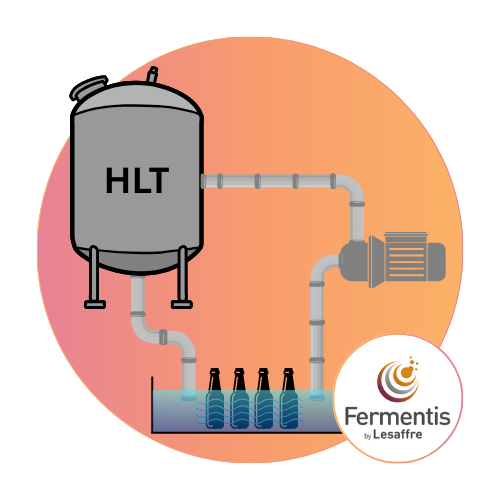Essential Safety Protocols and Risk Management Strategies Every Brewer Needs to Know
Non-alcoholic (NA) and low-alcohol (LA) beers—together known as NABLAB—are one of the fastest-growing segments in brewing. But unlike traditional beers, these products have fewer natural safeguards against contamination and spoilage. That makes process control, sanitation, and packaging stability absolutely critical.
In this guide, we’ll break down the essential safety protocols and risk management strategies from industry best practices and recent research, so you can brew NABLAB beers with confidence.
→ Additional Resources: Cautionary Notes on NABLAB Production
1. Understand the Unique Risks in NABLAB Brewing
![]() Regular beer benefits from a series of natural microbial “hurdles” that hinder the growth of spoilage organisms:
Regular beer benefits from a series of natural microbial “hurdles” that hinder the growth of spoilage organisms:
- Alcohol (inhibits microbial growth)
- Low pH (acidic environment)
- Hop compounds (antimicrobial)
- CO₂
- Nutrient limitations
NA and LA beers reduce or remove several of these hurdles. The result:
- Lower alcohol means less microbial protection
- Reduced alpha acid concentration from hops decreases antimicrobial effects
- Higher pH can favor spoilage growth
- Residual sugars increase the risk of refermentation
Takeaway: NABLAB brewing should be approached with the same care as food manufacturing.
2. Control pH for Safety
Lowering final beer pH to below 4.2 is a simple, effective way to make your product less hospitable to both spoilage organisms and pathogens.
Options for Adjusting pH:
- Adjust with acid additions such as Lactic Acid (88%), or Citric Acid
- Incorporate a small portion of Weyermann® Acidulated Malt in your grist bill
Regularly monitoring pH throughout brewing and packaging is one of the most reliable ways to confirm your best practices are delivering the results you want.
3. Eliminate Post-Boil Contamination Risks
Post-boil additions can introduce unwanted microorganisms. Commercial producers should avoid dry hopping NA or LA beers, and refrain from barrel aging, or adding fruit puree, spices, or other unpasteurized adjuncts after the boil.
Options for Post-Boil Additions:
- Hops: Use an alternative hop source, such as oils and extracts from Totally Natural Solutions
- Flavorings: Develop recipes that utilize Kerry Natural Flavourings
- Other Spices: if added during or after fermentation, always steam or heat-treat to avoid microbial contamination
If other flavor additions are necessary, use pasteurized or sterile ingredients and handle them in a sanitary environment.
4. Pasteurize or Use Equivalent Stabilization Methods
 Pasteurization is the gold standard for ensuring packaged NABLAB stability:
Pasteurization is the gold standard for ensuring packaged NABLAB stability:
- Tunnel Pasteurization: Most reliable for packaged beer, but requires additional infrastructure and equipment
- Small Batch Pasteurization: An effective way to avoid re-fermentation for small to medium brewers who do not have a tunnel pasteurization system
- Learn More from Fermentis: Step-by-Step Guide to Pasteurizing Small Batch NABLAB Beers
Without stabilization, NABLAB products are at significant risk for refermentation in the package, and unwanted growth of spoilage organisms causing off-flavors.
5. Audit Your Process for Contamination Risks
Common sources of unwanted microbes:
- Rinse water in tanks and lines
- Contaminated hoses or fittings
- Inadequate cleaning of packaging equipment
- Staff handling ingredients without proper sanitation practices
Action Step: Create a written hazard analysis identifying where contamination could occur and how to control it. Consider adding signage around your brewery’s production space to make staff aware of the added risk exposures.
6. Monitor Packaged Beer Stability
- Test for CO₂ increase or pressure changes over time
- Conduct sensory checks to detect souring or oxidation early
- Maintain traceability so any issues can be contained quickly
7. Stay Informed on Regulations and Research
Pathogen and spoilage research in NA beer is ongoing. The more we learn, the better equipped we are to make safe, shelf-stable products. Follow new studies, attend brewing conferences, and stay in touch with RahrBSG for the latest on process updates.
Final Takeaway
Brewing great NABLAB beer isn’t just about recipe design—it’s about controlling risk at every step. By lowering pH, eliminating contamination points, stabilizing through pasteurization or filtration, and following tight process controls, you can deliver a safe, consistent, and flavorful product that keeps customers coming back.
Ready to make NABLAB brewing part of your portfolio?
Contact RahrBSG for the ingredients, technical guidance, and process solutions to help you brew safe, great-tasting NA and low-alcohol beers.